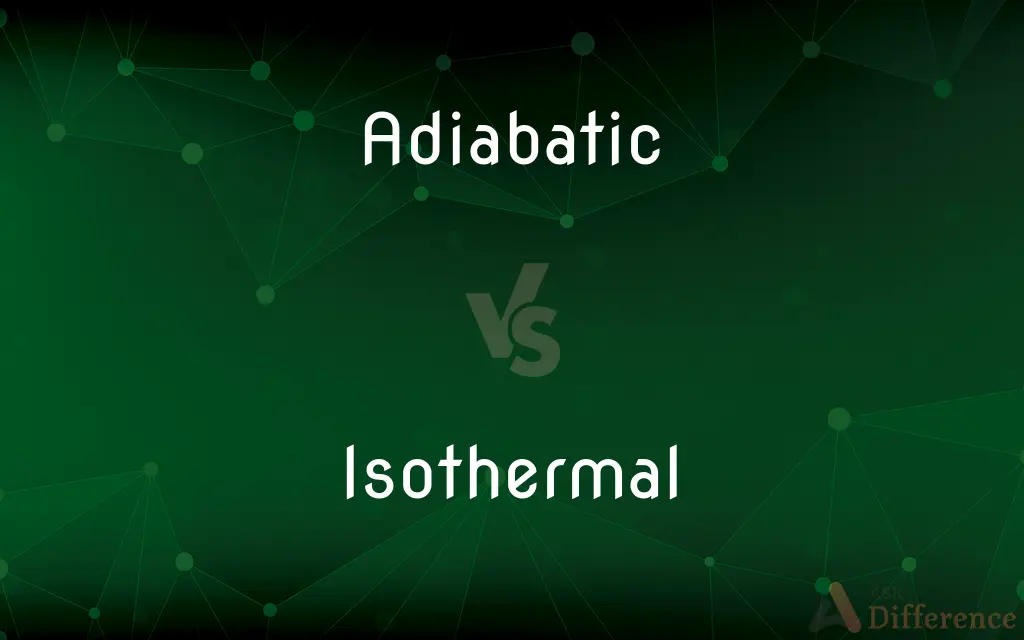Adiabatic vs. Isothermal — What's the Difference?
By Maham Liaqat & Urooj Arif — Updated on March 21, 2024
Adiabatic processes occur without heat exchange between a system and its environment, resulting in temperature changes, while isothermal processes involve temperature constancy, requiring heat transfer to or from the environment.

Difference Between Adiabatic and Isothermal
Table of Contents
ADVERTISEMENT
Key Differences
In adiabatic processes, a system does not exchange heat with its surroundings. This characteristic leads to changes in the system's temperature as it does work or work is done on it. For instance, when a gas compresses adiabatically, its temperature rises because the work done on the gas increases its internal energy. Conversely, in isothermal processes, the system's temperature remains constant throughout the process. This constancy is maintained by the transfer of heat between the system and its surroundings, ensuring that any work done is exactly balanced by heat exchange.
Adiabatic processes are characterized by rapid changes where there is no time for heat to enter or leave the system. This can be observed in phenomena such as meteorology, where rising and falling air masses change temperature without exchanging heat with the surroundings. On the other hand, isothermal processes are slower, allowing for heat exchange to occur, ensuring temperature constancy. This can be seen in controlled laboratory conditions where systems are kept at constant temperatures using thermal baths or other methods.
In practical applications, adiabatic processes are idealized situations often approximated in rapid mechanical operations, such as in internal combustion engines or compressors, where minimizing heat exchange is desirable for efficiency. Isothermal processes are crucial in chemical reactions conducted at constant temperatures to ensure reaction stability and control, as well as in processes requiring heat removal or addition, such as in refrigeration cycles.
Despite their differences, both concepts are fundamental in thermodynamics, highlighting the relationship between heat, work, and temperature in physical systems. Adiabatic processes emphasize energy conservation within a system, while isothermal processes underline the importance of temperature control through energy exchange with the environment.
Comparison Chart
Heat Exchange
None
Occurs to maintain constant temperature
ADVERTISEMENT
Temperature Change
Occurs due to work done
No change; remains constant
Speed of Process
Rapid, allowing no time for heat transfer
Slower, allowing heat transfer
Practical Examples
Internal combustion engines, meteorological phenomena
Chemical reactions, refrigeration cycles
Compare with Definitions
Adiabatic
Common in rapid mechanical processes.
The adiabatic cooling of air contributes to cloud formation.
Isothermal
Heat exchange balances work done.
Slow compression of gas with heat removal can be isothermal.
Adiabatic
Idealized in thermodynamics for efficiency.
Adiabatic conditions are assumed in the ideal gas cycle for engines.
Isothermal
Crucial in controlled chemical reactions.
Isothermal conditions ensure reaction rates remain stable.
Adiabatic
Process with no heat transfer.
Rapid expansion of gas in a piston can be approximated as adiabatic.
Isothermal
Used in refrigeration to remove heat.
The refrigeration cycle relies on isothermal heat absorption at the evaporator.
Adiabatic
Temperature changes due to work.
Compressing a gas adiabatically increases its temperature.
Isothermal
Process at constant temperature.
Melting ice in a water bath at 0°C is an isothermal process.
Adiabatic
Of, relating to, or being a reversible thermodynamic process that occurs without gain or loss of heat and without a change in entropy.
Isothermal
Of, relating to, or indicating equal or constant temperatures.
Adiabatic
That occurs without gain or loss of heat (and thus with no change in entropy, in the quasistatic approximation).
Isothermal
Of or designating changes of pressure and volume at constant temperature.
Adiabatic
That involves the slow change of the Hamiltonian of a system from its initial value to a final value.
Isothermal
Of or relating to an isotherm.
Adiabatic
An adiabatic curve or graph
Isothermal
An isotherm.
Adiabatic
Not giving out or receiving heat.
Isothermal
Of or pertaining to a process that takes place at constant temperature
Adiabatic
Occurring without loss or gain of heat;
Adiabatic expansion
Isothermal
Of or pertaining to an isotherm
Isothermal
(geography) An isotherm
Isothermal
Relating to equality of temperature, or an isotherm.
Isothermal
Of a process or change taking place at constant temperature
Common Curiosities
Can an adiabatic process be reversed?
Yes, an adiabatic process can be reversed. Both compression and expansion can occur without heat transfer, depending on the direction of the process.
How does an isothermal process work?
In an isothermal process, the system's temperature remains constant, achieved by balancing any work done with an equivalent amount of heat transfer.
Why are adiabatic processes important in thermodynamics?
Adiabatic processes are important because they highlight the conservation of energy within a system and are key in understanding the efficiency of engines and compressors.
What is a practical example of an isothermal process?
A practical example of an isothermal process is the melting of ice in a temperature-controlled environment, where the system absorbs heat without changing temperature.
What is an adiabatic process?
An adiabatic process is one in which a system does not exchange heat with its surroundings, leading to temperature changes due to work being done on or by the system.
Are adiabatic processes faster than isothermal ones?
Generally, adiabatic processes are faster than isothermal processes because they occur without the time needed for heat to enter or leave the system.
How are temperature and heat related in these processes?
In adiabatic processes, temperature changes without heat exchange, while in isothermal processes, temperature remains constant due to heat transfer balancing the work done.
Can the efficiency of an engine be improved by utilizing adiabatic or isothermal processes?
Yes, the efficiency of an engine can be improved by utilizing adiabatic processes for compression and expansion, minimizing heat loss, and isothermal processes in parts where heat needs to be added or removed efficiently. The idealized cycles in thermodynamics, like the Carnot cycle, demonstrate how these processes can theoretically optimize engine efficiency.
Can isothermal processes occur in nature?
Yes, isothermal processes can occur in nature, such as in thermal vents at the ocean floor, where the temperature is kept constant by the surrounding water.
What role does insulation play in adiabatic processes?
Insulation is crucial in adiabatic processes to prevent heat exchange with the surroundings, ensuring that any change in temperature is solely due to the work done on or by the system.
What makes a process adiabatic or isothermal?
A process is adiabatic if it allows no heat transfer, leading to temperature changes. It is isothermal if it involves heat exchange to maintain a constant temperature, regardless of work done.
What determines whether a process will be adiabatic or isothermal?
The determining factor is whether the system allows for heat exchange with its environment. If it does not allow for heat exchange, the process is adiabatic. If the system can exchange heat to maintain a constant temperature, the process is isothermal.
Why is it challenging to achieve a truly isothermal process in practical applications?
Achieving a truly isothermal process is challenging because it requires perfect heat exchange with the environment, which is difficult to maintain in real-world applications due to insulation imperfections and delays in heat transfer.
How does an adiabatic process affect the internal energy of a system?
In an adiabatic process, the change in the system's internal energy is directly related to the work done on or by the system since there's no heat exchange to affect internal energy.
Share Your Discovery

Previous Comparison
Circadian vs. Hemeral
Next Comparison
Mean vs. MoanAuthor Spotlight
Written by
Maham LiaqatCo-written by
Urooj ArifUrooj is a skilled content writer at Ask Difference, known for her exceptional ability to simplify complex topics into engaging and informative content. With a passion for research and a flair for clear, concise writing, she consistently delivers articles that resonate with our diverse audience.














































